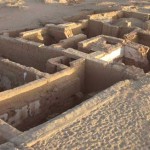 The ancient town of Amheida on the Dakhleh Oasis was and is hundreds of miles away from the political and cultural capitals of Egypt, but it’s been inhabited since the Stone Age and excavations indicate they kept up with the times.
The ancient town of Amheida on the Dakhleh Oasis was and is hundreds of miles away from the political and cultural capitals of Egypt, but it’s been inhabited since the Stone Age and excavations indicate they kept up with the times.
The early settlers were farmers, maybe even before the Nile valley got famous as a center of agriculture. Irrigation is a lot easier when you have a steady supply of water rather than a yearly flooding, as the copious remains of figs and olives indicate.
They also seemed to have been tapped in to the dominant culture, despite their physical distance from it. The Roman and Greek era art found on the site features contemporary mythology and deities.
Then there’s the school. Conventional wisdom has it that teachers were poorly paid and widely reviled generalists hired by parents of would-be functionaries to ensure salable literacy. Amheida’s school, however, tells a different story.
Divided into three rooms lined with benches for more than 50 students, it more closely resembled today’s formal institutions. Students were segregated by subject and age, and the teacher’s lessons were scrawled on the walls, which were treated like blackboards at the time. What remains of that writing has caught Cribiorre’s attention.
“There you have a poem written on the wall in the column in red ink. The poem speaks of rhetoric. It says, ‘come on, get up, get to work,'” she explained. “It’s encouragement from a teacher of rhetoric to his students. But it’s all poetry. In Greek.”
Scholars had thought that rhetoric, not poetry, was taught in Roman Egyptian schools. The schools churned out politicians and bureaucrats, aristocratic young men destined for leadership. Prior to the find, Cribiore had suspected that they might also have learned poetry, and this confirmed it. The teacher had written his lessons in verse, showing that schools from the period were more formal than once believed.